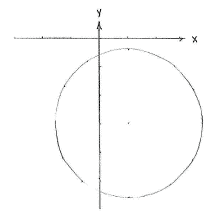Solution 4.1:7c
From Förberedande kurs i matematik 1
(Difference between revisions)
m (Lösning 4.1:7c moved to Solution 4.1:7c: Robot: moved page) |
|||
| Line 1: | Line 1: | ||
| + | By completing the square, we can rewrite the | ||
| + | <math>x</math> | ||
| + | - and | ||
| + | <math>y</math> | ||
| + | -terms as quadratic expressions, | ||
| + | |||
| + | |||
| + | <math>x^{2}-2x=\left( x-1 \right)^{2}-1^{2}</math> | ||
| + | |||
| + | |||
| + | <math>y^{2}+6y=\left( y+3 \right)^{2}-3^{2}</math> | ||
| + | |||
| + | and the whole equation then has standard form, | ||
| + | |||
| + | |||
| + | <math>\begin{align} | ||
| + | & \left( x-1 \right)^{2}-1+\left( y+3 \right)^{2}-9=-3 \\ | ||
| + | & \Leftrightarrow \quad \left( x-1 \right)^{2}+\left( y+3 \right)^{2}=7 \\ | ||
| + | \end{align}</math> | ||
| + | |||
| + | |||
| + | From this, we see that the circle has its centre at | ||
| + | <math>\left( 1 \right.,\left. -3 \right)</math> | ||
| + | and radius | ||
| + | <math>\sqrt{7}</math>. | ||
| + | |||
| + | |||
{{NAVCONTENT_START}} | {{NAVCONTENT_START}} | ||
<center> [[Image:4_1_7_c.gif]] </center> | <center> [[Image:4_1_7_c.gif]] </center> | ||
| - | <center> [[Image:4_1_7c.gif]] </center> | ||
{{NAVCONTENT_STOP}} | {{NAVCONTENT_STOP}} | ||
Revision as of 12:06, 27 September 2008
By completing the square, we can rewrite the \displaystyle x - and \displaystyle y -terms as quadratic expressions,
\displaystyle x^{2}-2x=\left( x-1 \right)^{2}-1^{2}
\displaystyle y^{2}+6y=\left( y+3 \right)^{2}-3^{2}
and the whole equation then has standard form,
\displaystyle \begin{align}
& \left( x-1 \right)^{2}-1+\left( y+3 \right)^{2}-9=-3 \\
& \Leftrightarrow \quad \left( x-1 \right)^{2}+\left( y+3 \right)^{2}=7 \\
\end{align}
From this, we see that the circle has its centre at
\displaystyle \left( 1 \right.,\left. -3 \right)
and radius
\displaystyle \sqrt{7}.

